HTML
-
偏光棱镜是现代光信息技术发展与产业化的基础无源器件,是激光应用和调制技术的关键器件,在光纤通讯、光信息处理、偏振干涉成像以及精密光学遥感系统等领域得到广泛应用[1-7]。目前大部分晶体偏光器件是由冰洲石晶体制作而成,冰洲石晶体是一种天然矿物,为无色透明的光学级方解石(CaCO3),但是,冰洲石晶体在紫外波段的透射性能稍有瑕疵。一般的晶体在小于400nm的波段,对光的透射比迅速降低,到260nm基本截止,只有优选的冰洲石晶体在220nm处仍有较高的透过率[8],但是在自然界中优选的冰洲石晶体储量稀少。冰洲石-氟化钡紫外偏光镜,基于氟化钡(BaF2)在紫外区具有良好的透射性能,以及其折射率(氟化钡属于立方晶系,寻常光与非常光折射率相同)和冰洲石晶体中非常光(e光)主折射率近似相等的性质,按格兰-泰勒棱镜结构设计而成。该冰洲石-氟化钡紫外偏光镜的光线入射端为直角冰洲石棱镜,光线出射端为氟化钡棱镜,两部分采用空气隙形式胶合在一起,可以节省优选冰洲石晶体的用量。
之前对于冰洲石-氟化钡紫外偏光镜的研究集中于某一光束的平行出射[9-11],未见有关于冰洲石-氟化钡紫外直角分束偏光镜的报导。直角分束偏光镜能够出射寻常光(o光)、非常光(e光)两束光线, 并且o光、e光的分束角是直角,能给光路的设计和调整提供极大的方便,所以有较为广泛的研究、设计以及应用[12-15]。本文中给出了一种紫外直角分束偏光镜的设计,并对该棱镜的分束特性进行了理论计算。
-
在冰洲石-氟化钡紫外偏光棱镜中,除了e光(本文中o光、e光是针对冰洲石晶体而言)出射有偏离角之外,o光出射方向与入射光线方向也有夹角。通过对棱镜中氟化钡部分的出射端进行设计修改,可使出射e光光线方向平行于入射光线方向[9]。为进一步对o光分析和有效地利用o光,对棱镜进行设计,使其出射的o光光束方向与出射e光光线方向成90°夹角。其主截面和光路图如图 1所示。
图 1中,双箭头表示冰洲石晶体光轴的方向,冰洲石晶体和氟化钡晶体中间为空气隙,棱镜的结构角分别为S1, S2, S3,γ是o光在冰洲石晶体与空气交界面处的入射角,δ为o光在冰洲石晶体与空气交界面处的折射角。令o光从冰洲石出射后折射光线方向垂直入射光,从而实现直角分束的功能。下面对结构角S2进行分析。在冰洲石与空气的交界面处,由折射定律可得:
式中, no表示的是冰洲石晶体中o光的主折射率。
最终求得结构角S2与S1和o光折射率no满足的关系为:
即结构角S2在满足(2)式条件的情况下,棱镜可以实现o光光束与e光光束的垂直分束。
结构角S3与S1的关系为[11]:
式中, ne表示的是冰洲石晶体中e光的主折射率,nb表示的是氟化钡的折射率。
以波长为265.6nm的紫外光为例,氟化钡的折射率为nb=1.51216,冰洲石的主折射率为:no=1.74864,ne=1.52547[16]。利用全反射临界角公式,可以得到在冰洲石和空气隙分界面处的o光全反射角为34.9°,e光全反射角为41.0°。为保证o光的全反射效果,同时避免e光发生全反射,并且考虑到偏光镜要有一定的视场角,结构角S1取值为38.0°,由(2)式得到相应的结构角S2取值为20.7°,由(3)式可以得到结构角S3取值为39.2°。
-
为方便起见,在这里先约定:(1)入射光为单色自然光或是偏振面与紫外直角分束偏光镜中e光、o光的偏振面成45°的单色线偏振光;(2)光在紫外直角分束偏光镜的视场角内入射;(3)入射角角度正负号的定义为:沿光传播的方向观察,光线转到界面法线,顺时针所成的角为负,逆时针所成的角为正[12]。紫外直角分束偏光镜的光路如图 2所示。其中图 2a为o光在棱镜中的传播路线,图 2b为e光在棱镜中的传播路线。光线入射角为θi,进入冰洲石后分为o光和e光,o光的折射角为θo,e光的折射角为θe;在冰洲石和氟化钡的交界面处,o光的反射角为θo, r,e光的入射角为θe, i,折射角为θe, t;在冰洲石与空气的交界面处,o光的入射角为θo, i,折射角为θo, t;在氟化钡和空气的交界面处,e光的入射角为θe, i′,折射角为θe, t′。接下来分别对o光和e光进行分析。
对o光进行分析,在空气-冰洲石交界面处以及在冰洲石-空气交界处,分别应用折射定律,最终可以得到o光出射角和入射角的关系:
对e光进行分析,在空气-冰洲石交界面处、冰洲石-氟化钡分界面处以及氟化钡-空气交界面处,分别应用折射定律,最终得到e光出射角和入射角的关系:
最终得到的关于o光与e光的分束角关系式为:
以入射光波长为265.6nm时设计的棱镜为例,入射光波长为265.6nm,此时,氟化钡的折射率为nb=1.51216,冰洲石的主折射率为:no=1.74864,ne=1.52547。当入射角θi从-3.0°变化到+3.0°时,由(4)式~(6)式做出o光、e光分束角与入射角的关系曲线,如图 3所示。
由图 3可以看出,在±3.0°入射角范围内,偏光镜的分束角与入射角基本呈线性变化的关系,且分束角与直角的偏差在-6.5°~+6.5°之间,该偏差角度约为入射角的2倍。
-
以入射光波长为265.6nm时设计的棱镜为例,光线正入射,分析紫外直角分束棱镜分束角的光谱特性。冰洲石晶体的色散方程为[17]:
氟化钡的色散公式为[16]:
将以上公式代入到(4)式~(6)式,注意此时光线为正入射,入射角θi=0°,通过计算机软件得出o光、e光的折射角和偏光镜的分束角随入射光波长的变化曲线,如图 4所示。
由图 4可知,当光垂直入射时,分束角随波长的减少而非线性减小,在240nm~400nm的宽波段范围内,分束角与直角的偏差小于1.0°,表明该棱镜具有较宽的适用光谱范围。
2.1. 分束角的入射角特性
2.2. 分束角的光谱特性
-
图 5是紫外直角分束偏光镜的光路图。因为此时是分析棱镜的光强分束比(即强度比,无量纲),所以此处在分析光路时要考虑到胶合层空气隙对光路的影响。为了在计算中方便,同时也便于与上文中的光路分析区别开来,对光路中的各个角度重新定义编号,如图中所示,α1是入射角,α3和α5是o光的入射角,α2和α6是o光折射角,α4是o光的反射角,α8, α10和α12是e光的入射角,α7, α9, α11和α13分别是e光的折射角。图 5a是o光在棱镜中的传播路线,其经过1,2,5界面;图 5b是e光在棱镜中的传播路线,其分别经过1,2,3,4界面。
由菲涅耳公式,o光在各个界面的光强反射率[18]为:
然后令Io, 1, Io, 2, Io, 5分别表示o光通过各个界面后的光强,则:
可以得到通过紫外直角分束偏光镜的o光光强为:
式中,I是入射光的光强。
对于e光,其在各个界面的光强反射率分别为:
令Ie, 1, Ie, 2, Ie, 3和Ie, 4表示e光通过各个界面后的光强,则:
可以得到通过紫外直角分束偏光镜的e光光强为:
则可以得到紫外直角分束偏光镜的光强分束比F(即强度比,无量纲)为:
-
以入射光波长为265.6nm时设计的棱镜为例,光线的入射角为α1,当入射角从-3.0°变化到+3.0°时,由(9)式~(15)式做出偏光镜光强分束比与入射角的关系曲线,如图 6所示。
由图 6可知,棱镜e光、o光的光强分束比约为1: 1;入射角为正时,光强分束比随入射角变化比较大,入射角为负时,光强分束比变化较缓慢。对光强分束比有要求的使用者在使用该棱镜时要特别注意光强分束比的这一变化特点。
-
以入射光波长为265.6nm时设计的棱镜为例,光线正入射于偏光镜,分析紫外直角分束偏光镜光强分束比的光谱特性。由于光线是正入射到偏光镜上,所以在(9)式和(12)式中,α1=0°。由(9)式~(15)式做出偏光镜光强分束比与入射光波长的关系曲线,如图 7所示。
由图 7可以看出,该棱镜的光强分束比在240nm~400nm波段内随着波长的增加而非线性增大,与1的偏差在0.02以内,并且波长越长变化越缓慢,这表明该棱镜在较宽的波段内具有良好的分束比稳定性。
3.1. 紫外直角分束偏光镜光强分束比的理论分析
3.2. 入射角对偏光镜光强分束比的影响
3.3. 光强分束比的光谱特性
-
采用冰洲石晶体与氟化钡晶体二元复合的方案,设计了一种冰洲石-氟化钡紫外直角分束棱镜,并且以波长为265.6nm的紫外光为例给出了设计实例。该设计不但实现了偏光棱镜光路的直角分束,而且还具有优质冰洲石晶体用料省、制作成本低的特点。
(1) 棱镜分束角与直角偏差小,且分束角与直角的偏差约为入射角的2倍。
(2) 棱镜具有较宽的光谱适用范围,在240nm~400nm的波段范围内,垂直入射对应的直角分束偏差小于1.0°。
(3) 棱镜e光、o光的光强分束比约为1: 1,垂直入射时,在240nm~400nm波段范围内的光强分束比与1的偏差在0.02以内。该紫外直角分束偏光镜的设计和理论分析,对以后直角分束棱镜的设计、制作以及实际使用具有理论指导价值。

 Map
Map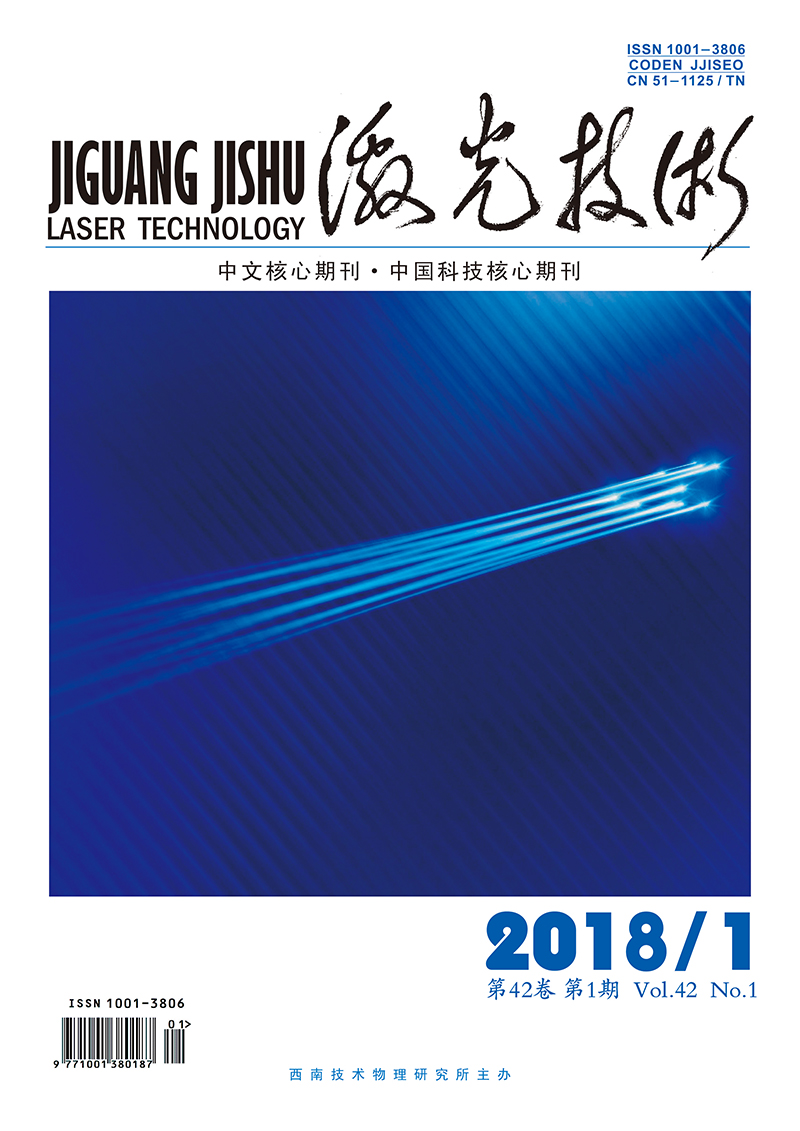




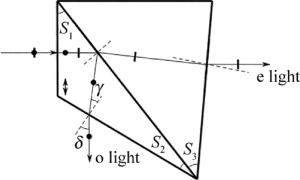
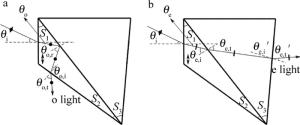
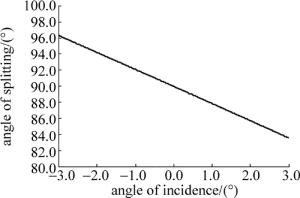
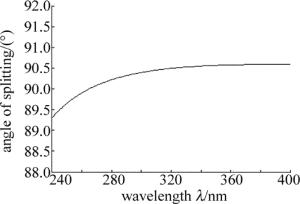
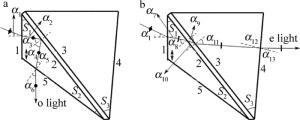


 DownLoad:
DownLoad:





